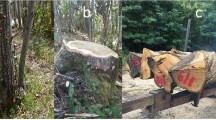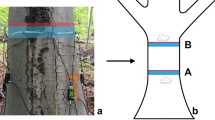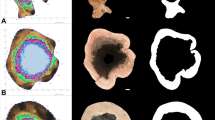Abstract
Picus® acoustic tomography was used to map incipient stages of fungal decay in the sapwood of standing Douglas fir, beech, oak, and sycamore trees 2, 16, and 27 months after wounding and artificial inoculation with brown-, soft-, and white-rot decay fungi. Some wood properties were additionally measured before (velocity of sound) and after (moisture content, weight loss, and density of sound, discoloured and/or decayed wood) tree felling (28 months). With the exception of Trametes versicolor in sycamore, wood decay was not evident from the tomograms in any host-fungus combination. In comparison to measurements after two months, the device recorded a reduction in sound velocity in some host-fungus combinations after 16 and 27 months. In beech, there was a significant reduction in sound velocity after inoculation with Ganoderma applanatum, Kretzschmaria deusta, and Trametes versicolor. Similarly, a reduction in sound velocity was recorded in sycamore inoculated with Kretzschmaria deusta and Trametes versicolor. In all these combinations, losses in wood weight and wood density were also found. Results showed that the detection of incipient fungal decay at the periphery of tree stems needs to be improved such that tomograms of the Picus® acoustic tomograph are capable of identifying decay progressing from the sapwood inwards.






Similar content being viewed by others
References
Blanchette RA, Otjen L, Effland MJ, Eslyn WE (1985) Changes in structural and chemical components of wood delignified by fungi. Wood Sci Technol 19:35–46
Bucur V (2003) Nondestructive characterization and imaging of wood. Springer, Berlin
Catena A (2003) Thermography reveals hidden tree decay. Arb J 27:27–42
Catena A, Catena G (2003) Thermography: a truly non invasive method to detect cavities and rot in trees (roots, trunk and branches) at a distance and from the ground. In: Second international symposium on plant health in urban horticulture, Berlin, 27–29 August, 231
Deflorio G (2006) Wood decay dynamics in the sapwood of trees—in vitro and in vivo studies on the role of the wood substrate in decay development. Cuvillier, Goettingen
Eaton RA, Hale MDC (1993) Wood-decay, pests and protection. Chapman & Hall, London
Gilbert EA, Smiley ET (2004) Picus sonic tomography for the quantification of decay in white oak (Quercus alba) and hickory (Carya spp.). J Arb 30:277–281
Gilbertson RL (1980) Wood-rotting fungi of North America. Mycologia 72:1–49
Habermehl A, Ridder HW (1995) Computerised tomographic investigations of street and park trees. Arb J 19:419–437
Hepting GH, Roth ER, Sleeth B (1949) Discoloration and decay from increment borings. J For 47:366–370
Kaestner A, Niemz P (2004) Non-destructive methods to detect decay in trees. Wood Res 49:17–28
Kersten W, Schwarze FWMR (2005) Development of decay in the sapwood of trees wounded by the use of decay detecting devices. Arb J 28:165–181
Kucera LJ, Niemz P (1998) Fäule in Bäumen erkennen. Wald Holz 2:27–30
Lonsdale D (1999) Principles of tree hazard assessment and management. Stationery Office Ltd, Publications Centre, London
Lorenz RC (1944) Discolorations and decay resulting from increment borings in hardwoods. For 42:37–43
Nicolotti G, Socco LV, Martinis R, Godio A, Sambuelli L (2003) Application and comparison of three tomographic techniques for detection of decay in trees. J Arb 29:66–78
Niemz P, Bodmer H-C, Kucera LJ, Ridder HW, Habermehl A, Wyss P, Zürcher E, Holdenrieder O (1998) Eignung verschiedener Diagnosemethoden zur Erkennung von Stammfäulen bei Fichte. Schweiz Z Forstw 149:615–630
Nobles MK (1958) Cultural characters as a guide to the taxonomy and phylogeny of the Polyporaceae. Can J Bot 36:883–926
Ouis D (2003) Non-destructive techniques for detecting decay in standing trees. Arb J 27:159–177
Picus (2003) Gebrauchsanleitung des PICUS-Schalltomographen. Argus Elektronik GmbH, Rostock
Picus (2007) Picus home page. Temperaturbereich vom Picus. <http://www.picus-online.de/picus/system/stomgrd.htm> Accessed 02 July 2007
Rabe C, Ferner D, Fink S, Schwarze FWMR (2004) Detection of decay in trees with stress waves and interpretation of acoustic tomograms. Arb J 28:3–19
Rayner ADM, Boddy L (1988) Fungal decomposition of wood: its biology and ecology. Wiley, Chichester
Rinn F (2003) Technische Grundlagen der Impuls-Tomographie. Baumzeitung 8:29–31
Rinn F (2004) Holzanatomische Grundlagen der Schall-Tomographie an Bäumen. Neue Landschaft 7:44–47
Roll-Hansen F, Roll-Hansen H (1980a) Microorganisms which invade Picea abies in seasonal stem wounds. I. General aspects. Hymenomycetes. Eur J Plant Path 10:321–339
Roll-Hansen F., Roll-Hansen H (1980b) Microorganisms which invade Picea abies in seasonal stem wounds. II. Ascomycetes, Fungi imperfect, and bacteria. General discussion, Hymenomycetes included. Eur J Plant Path 10:396–410
Rust S (2001) Baumdiagnose ohne Bohren. AFZ-Der Wald 18:924–925
Rust S, Franz S, Minke M, Schumann I, Roloff A (2002) Schalltomographie zur Erkennung von Fäulen und Höhlungen an stehenden Bäumen. Stadt und Grün 6:50–52
Schöpfer W (1961) Die Bohrspanentnahme von Waldbäumen. Allg Forstzeitung 19:297–300
Schwarze FWMR, Fink S (1994) Ermittlung der Holzzersetzung am lebenden Baum. Neue Landschaft 39:182–193
Schwarze FWMR, Lonsdale D, Mattheck C (1995) Detectability of wood decay caused by Ustulina deusta in comparison with other tree-decay fungi. Eur J For Path 25:327–341
Schwarze FWMR, Lonsdale D, Fink S (1997) An overview of wood degradation patterns and their implications for tree hazard assessment. Arb J 21:1–32
Schwarze FWMR, Baum S (2000) Prognose der Fäuledynamik im lebenden Baum. Stadt und Grün 10:687–693
Schwarze FWMR, Engels J, Mattheck C (2004) Fungal strategies of wood decay in trees. Springer, Berlin
Schwarze FWMR, Heuser C (2006) Stem wounds—potential entry courts for wood decay fungi? Arb J 29:101–119
Shigo AL (1972) Successions of microorganisms and patterns of discoloration and decay after wounding in red oak and white oak. Phytopathol 62:256–259
Shigo AL (1976) Microorganisms isolated from wounds inflicted on red maple, paper birch, American beech, and red oak in winter, summer and autumn. Phytopathol 66:559–563
Uitenbroek DG (1997) SISA t test. <http://home.clara.net/sisa/t-thlp.htm#RateR> Accessed 06 November 2006
Wang X, Wiedenbeck J, Ross RJ, Forsman JW, Erickson JR, Pilon C, Brashaw BK (2005) Nondestructive evaluation of incipient decay in hardwood logs. Gen Tech Rep FPL-GTR-162. USDA, Forest Service, Forest Products Laboratory (Madison, USA)
Watling R (1982) Taxonomic status and ecological identity in the basidiomycetes. In: Frankland JC, Hedger JN, Swift MJ (eds) Decomposers basidiomycetes: their biology and ecology. Cambridge University Press, Cambridge, pp 1–32
Whitney RD, Denyer WBG (1969) Resin as a barrier to infection of white spruce by heartrotting fungi. For Sci 15:266–267
Wilkins WH (1934) Studies in the genus Ustulina with special reference to parasitism. I. Introduction, survey of previous literature and host index. Trans Brit Mycol Soc 18:320–346
Wilkins WH (1936) Studies in the genus Ustulina with special reference to parasitism. II. A disease of the common lime (Tilia vulgaris Hayne) caused by Ustulina. Trans Brit Mycol Soc 20:133–156
Wilkins WH (1939) Studies in the genus Ustulina with special reference to parasitism. V. A disease of elm (Ulmus campestris Sm.) caused by Ustulina. Trans Brit Mycol Soc 23:171–185
Acknowledgments
The authors wish to thank the company “Institut für angewandte Baumpathologie” (Freiburg i.Brsg., Germany) for lending the device and the producer (Dr. Gustke GmbH, Germany) for granting two device sensors. The authors are indebted to Mr. Volker Kieber (Forest Service of the Region Baden-Wuerttemberg, Germany) for providing tree material of the Mooswald forest (Freiburg i.Brsg., Germany), and to Dr. David Ferner and Dr. Steffen Rust for technical advice. Field assistance of Mr. Robert Dietrich, Mr. Walter Drescher, Ms. Sigrid Hagenguth, and Mr. Karl Merz (Forest Botany Institute, Faculty of Forest and Environmental Sciences, University of Freiburg, Germany) is greatly acknowledged. Dr. Jutta Holst and Prof. Andreas Matzarakis (Meteorology Institute, University of Freiburg, Germany) kindly provided data on daily temperature in Freiburg. Ms. Giuliana Deflorio was supported by a scholarship from the DAAD (Deutscher Akademischer Austausch Dienst, Germany) to carry out Ph.D. studies. Also, laboratory material was partly granted by the IPP program “Forestry in transition” of the Faculty of Forest and Environmental Sciences (University of Freiburg, Germany).
Author information
Authors and Affiliations
Corresponding author
Rights and permissions
About this article
Cite this article
Deflorio, G., Fink, S. & Schwarze, F.W.M.R. Detection of incipient decay in tree stems with sonic tomography after wounding and fungal inoculation. Wood Sci Technol 42, 117–132 (2008). https://doi.org/10.1007/s00226-007-0159-0
Received:
Published:
Issue Date:
DOI: https://doi.org/10.1007/s00226-007-0159-0




